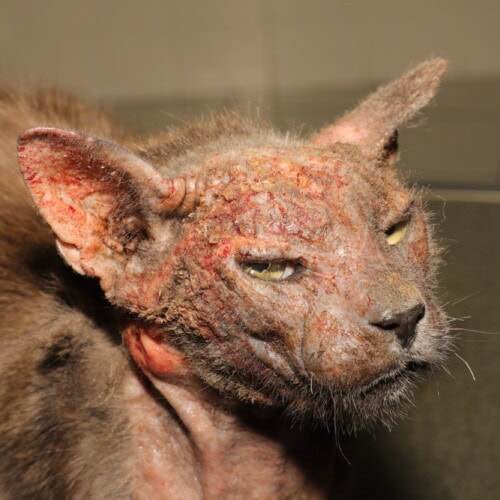Sarcoptic mange is an ectoparasitic disease caused by the arthropod *Sarcoptes scabiei* from the family Sarcoptidae. While this parasite has been isolated in several domestic and wild mammal species, infestation in cats is considered extremely rare.
This case series presents the clinical observations and treatment of *Sarcoptes scabiei* infestation in three cats in Poland.
Case Presentations
Three cats were presented separately for evaluation of rapidly developing skin lesions and severe pruritus. Clinical signs were first observed 2 weeks prior to presentation in cat #1 and #3, and 1 week prior to presentation in cat #2. No comorbidities were identified in any of the cases based on medical history. All three cats came from single-pet households and had outdoor access. None of the owners reported personal signs of mange infestation.
Clinical Features
Using the four-point verbal rating scale (VRS), all owners rated their cat’s pruritus as severe (4/4), although the location of pruritus varied among the three cats:
– Cat #1: Pruritus and lesions affecting the neck, right elbow, lateral surface of the forelimbs, posterior surface of the left thigh, and abdomen.
– Cat #2: Pruritus only on the right side of the lateral aspect of the thorax.
– Cat #3: Lesions and pruritus mainly on the head, ear pinnae, back, and tail.
All cats exhibited alopecia/hypotrichosis, erosions, and crusts. Papules were present in only two of the cats (#1 and #3).
Diagnosis
Skin scrapings were performed on an affected area in each case. In each case, a single *S. scabiei* mite was observed in the skin scraping samples by the clinician. The collected specimens were transferred to the laboratory of the University of Life Sciences in Lublin, where confirmation and identification of the parasite were performed by a parasitologist. Various developmental forms (egg, nymph, and adult) of *S. scabiei* were found in the samples.
Discussion
Although sarcoptic mange is more common in dogs, the clinical picture in cats appears to be more varied. Unlike in dogs where papules are the predominant lesion, crusts seem to be a more consistent clinical feature of mange in cats. Similarly, while all cats had crusts, only two of the three cats had papules.
The incidence and severity of pruritus in feline sarcoptic mange have been variously described in literature. In this case series, all cats exhibited marked pruritus, unlike some previous reports where pruritus was not always observed or was not a predominant clinical sign.
The location of lesions was also variable and differed from the typical pattern observed in dogs. Interestingly, cat #2 had lesions localized exclusively to one side of the lateral thoracic region, which is not a typical location for canine sarcoptic mange.
While previous reports suggest that sarcoptic mange affects older cats, the younger age of cats #2 (7 years old) and #3 (2 years old) presented here suggests that this is not always the case.
Consider sarcoptic mange in cases of cervicofacial pruritus in cats
Conclusions
In conclusion, sarcoptic mange is a rare parasitic infection in cats. The clinical presentation of feline mange appears to be more variable than in dogs, particularly in terms of the degree of pruritus and lesion location. Crusts and pruritus appear to be equally important signs of *Sarcoptes* infestation in cats.
Although rare, it is important that *Sarcoptes scabiei* infestation be considered as a differential diagnosis for cats presenting with pruritic inflammatory skin disease. The possibility of zoonotic spread has public health implications.
FAQs
What are the clinical signs of sarcoptic mange in cats?
The most common clinical signs are intense pruritus and the presence of crusts on the skin. Other lesions, such as papules, erosions, and alopecia, may also be observed. The location of the lesions is variable.
How is sarcoptic mange diagnosed in cats?
Diagnosis is confirmed by demonstrating the parasite (*Sarcoptes scabiei*) through microscopic examination of skin scrapings.
Is sarcoptic mange contagious to humans?
Yes, *Sarcoptes scabiei* is a zoonotic parasite, meaning it can be transmitted from animals to humans.
How can sarcoptic mange be prevented in cats?
Prevention is based on good hygiene, especially if the cat has outdoor access, and the use of topical or systemic acaricides. It is important to treat all animals in contact with an animal affected by mange.
Marcin Szczepanik, Piotr Wilkolek,Grzegorz Kalisz and Klaudiusz Szczepaniak Feline sarcoptic mange in Poland: A case series of three cats. Vet Med Sci v.10(4); 2024 Jul PMC11167402
Related Searches
cat hypotrichosis, cornish rex, hair, test, kittens, kitten, breed, coat, belly, syndrome, dermatology, conditions, name, great britain, appearance, hair loss, causes, colombo s, european, symptoms, air, life expectancy, mutations, phenomenon, condition, cause, end, companion, ears, hair loss, loss, origins, veterinarian, other, mutation, disorders, point, behavior, problems, treatments, hair, breeders, through, level, diet, paws, sphynx, aspect, diet, children, episodes, guard hair, people, kibble, birth, selection, effect, example, number, baldness
